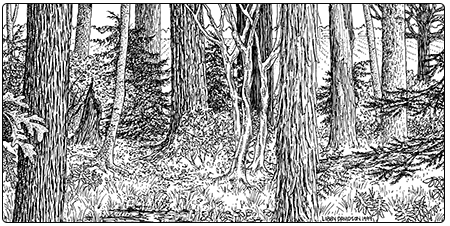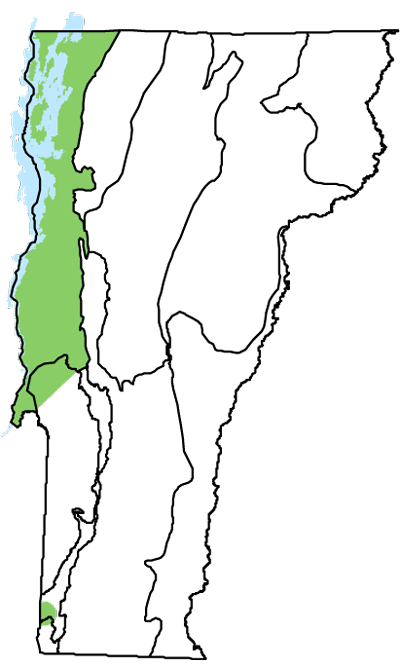The Clayplain Forest Ecosystem
The clayplain forest is best considered an ecosystem composed of several closely-related forest types occurring together as a mosaic on the glacial lacustrine and marine soils of the Champlain Valley. Two natural community types of the clayplain forest ecosystem are uplands (Mesic Clayplain Forest and Sand-Over-Clay Forest) and two are wetlands (Wet Clayplain Forest and Wet Sand-Over-Clay Forest).
The clayplain forest ecosystem covered nearly 220,000 acres of the post-glacial lake and marine plain of the Champlain Valley prior to European settlement. The predominately clay soils of these forests formed from sediments deposited in the Champlain Valley during and following the Pleistocene glaciation, both when the valley was flooded by a large freshwater lake, and later when salt water invaded the basin from the north. Moisture in these soils varies considerably with soil texture, topographic position, and slight elevation differences. In localized areas, lenses of sand and silt lie over the clay and result in variations in the forest communities.
These deep, fertile, stone-free soils have been prized for agriculture, and the majority of the clayplain forest has been cleared since the time of European settlement. The most well-drained areas of the clayplain were preferentially cleared for agriculture and the clayplain forests remnants that are left are generally on the moister sites, although they typically contain a mosaic of wet and mesic areas. It is presumed that the clayplain was nearly 100 percent forested prior to European settlement, but today only 12 percent of the clay soil in the southern Champlain Valley supports forest (Lapin 2003). Because of forest conversion, all four clayplain forest natural community types are rare in Vermont.
Ecology and Physical Setting
Mesic Clayplain Forest is the most widespread of the four clayplain natural community types, and it dominated the clay soils of the Champlain Valley prior to European settlement. It typically occurs on slightly elevated or sloping parts of the clayplain and has moderately well drained to somewhat poorly drained soils, often of the Vergennes series. Small pools and wet hollows may be scattered throughout. Soil fertility is generally high but soils can be acidified locally under conifers. Because of the dense and seasonally wet soils, trees are typically shallow-rooted and are easily blown over during heavy winds. Tip-up mounds are therefore a common sight in these forests. Mesic Clayplain Forest is considered the matrix forest of the Champlain Valley, even though it no longer functions as a matrix forest as a result of conversion and fragmentation.
Vegetation
 Mesic Clayplain Forest has one of the richest assemblage of tree species of any natural community in Vermont. The towering trees, the plant diversity, and the level plain make a walk in a Mesic Clayplain Forest a memorable experience. The closed canopy in these forests most commonly includes white oak, red oak, red maple, white pine, shagbark hickory, sugar maple, and white ash. Associated species include hemlock, beech, swamp white oak, bur oak, basswood, American elm, black cherry, bitternut hickory, green ash, black ash, and quaking aspen. Hophornbeam and musclewood are common understory trees. As in other clayplain forest types, hemlock can dominate the canopy locally.
Mesic Clayplain Forest has one of the richest assemblage of tree species of any natural community in Vermont. The towering trees, the plant diversity, and the level plain make a walk in a Mesic Clayplain Forest a memorable experience. The closed canopy in these forests most commonly includes white oak, red oak, red maple, white pine, shagbark hickory, sugar maple, and white ash. Associated species include hemlock, beech, swamp white oak, bur oak, basswood, American elm, black cherry, bitternut hickory, green ash, black ash, and quaking aspen. Hophornbeam and musclewood are common understory trees. As in other clayplain forest types, hemlock can dominate the canopy locally.
The shrub layer is typically well developed and diverse, and includes witch hazel, maple-leaved viburnum, prickly ash, beaked hazelnut, and riverbank grape. The herb layer is similarly dense and very diverse. Characteristic species include barren strawberry and grove sandwort. Other common species include wild geranium, wild oats, large enchanter’s nightshade, graceful sedge, spreading sedge, hog peanut, sharp-lobed hepatica, and white avens. Slight changes in microtopography yield changes in species composition. Small rises support dry-site species such as low sweet blueberry and wild oats, while hollows harbor wet site species such as winterberry holly and sensitive fern.
Wildlife Habitat
Because the Champlain Valley has lost much of its forest to agricultural conversion and development, the remaining forests, wetlands, and riparian areas have a disproportionately high importance for wildlife. Mesic Clayplain Forest, with its diversity of oaks and hickories, provides hard mast for many wildlife species.
Although black bears are closely associated with hard mast producing trees, breeding bears are notably rare or absent in clayplain forests because of the fragmented condition of the lower Champlain Valley. The large shagbark hickory trees of mature clayplain forests provide roosting sites for Indiana bats and other bat species.
Many species of birds breed in the clayplain forest ecosystem, including sharp-shinned and Coopers hawks, black-billed cuckoo, blue-headed vireo, wood thrush, eastern wood pewee, and Baltimore oriole. Red-bellied woodpecker, tufted titmouse, and Carolina wren are all expanding their ranges from the south into clayplain forests.
The moist soils, abundant decaying hardwood, and the interspersion of Wet Clayplain Forest make the clayplain forest ecosystem important for amphibians. Spotted salamanders, blue-spotted salamanders, eastern red-backed salamanders, wood frogs, and gray treefrogs may all be abundant in Mesic Clayplain Forests if vernal pool habitat is nearby.
Successional Trends
White pine is a common early successional species on clay soils. Green ash and quaking aspen are also early-successional species in these areas, along with eastern red cedar, red maple, bur oak, and white ash. Prickly ash and gray dogwood are two native species that can be abundant on abandoned clay fields and may persist for decades.
Related Communities
- Wet Clayplain Forest occurs on wetter clay soils, typically Covington, Panton, Kingsbury, and Livingston soils. It is commonly found as an inclusion within Mesic Clayplain Forest. Dominant trees include green ash, black ash, swamp white oak, bur oak, red maple, and hemlock. This is a wetland natural community.
- Sand-Over-Clay Forest is also a component of the clayplain forest ecosystem but has a layer of sandy soil overlying clay and is typically drier and less nutrient-rich than Mesic Clayplain Forest.
- Mesic Maple-Ash-Hickory-Oak Forest is found on better-drained, till-derived soils in the warm climate regions of the state. It shares many species in common with the drier examples of Mesic Clayplain Forest.
Conservation Status and Management Considerations
This is one of the most severely altered communities in Vermont. Its present size is a small fraction of its original extent, and the exact nature and composition of the original clayplain forests are not known. The remaining examples are mostly smaller than one hundred acres and are often separated from one another by agricultural land, making plant and animal dispersal between sites difficult. A few good examples are found on state and private conservation lands, but many examples remain vulnerable to clearing and conversion. The long-term conservation of the clayplain landscape will require protecting the remaining examples, restoring some agricultural land back to clayplain forest, and re-establishing riparian connections. Non-native invasive shrubs, including honeysuckles, buckthorn, and barberry are a major threat to this fragmented and nutrient-rich community. Aggressive control is needed to maintain the ecological integrity. Restoring this magnificent ecosystem is a challenging but exciting proposition.
Distribution/Abundance
This community is known primarily from the Champlain Valley of Vermont, New York, and Québec. A similar clayplain ecosystem occurs on clay soils adjacent to the lower Great Lakes.
Characteristic Plants
Trees
Abundant Species
White oak – Quercus alba
Red oak – Quercus rubra
Red maple – Acer rubrum
Shagbark hickory – Carya ovata
Sugar maple – Acer saccharum
White pine – Pinus strobus
Occasional to Locally Abundant Species
Swamp white oak – Quercus bicolor
Bur oak – Quercus macrocarpa
White ash – Fraxinus americana
Eastern hemlock – Tsuga canadensis
Basswood – Tilia americana
Hophornbeam – Ostrya virginiana
American beech – Fagus grandifolia
Musclewood – Carpinus caroliniana
Black cherry – Prunus serotina
Bitternut hickory – Carya cordiformis
Green ash – Fraxinus pennsylvanica
Quaking aspen – Populus tremuloides
Bigtooth aspen – Populus grandidentata
Shrubs
Abundant Species
Maple-leaved viburnum – Viburnum acerifolium
Witch hazel – Hamamelis virginiana
Prickly ash – Zanthoxylum americanum
Gray dogwood – Cornus racemosa
Occasional to Locally Abundant Species
Beaked hazelnut – Corylus cornuta
Riverbank grape – Vitis riparia
Low sweet blueberry – Vaccinium angustifolium
Dwarf raspberry – Rubus pubescens
Swamp dewberry – Rubus hispidus
Carolina rose – Rosa carolina
Canada honeysuckle – Lonicera canadensis
Poison ivy – Toxicodendron radicans
Herbs

Clayplain Forest than any other community.
Barren strawberry – Geum fragarioides
Grove sandwort – Moehringia lateriflora
Wild oats – Uvularia sessilifolia
Wild geranium – Geranium maculatum
Bearded shorthusk – Brachyelytrum aristosum
Large enchanter’s nightshade – Circaea canadensis
Graceful sedge – Carex gracillima
Hog peanut – Ampicarpaea bracteata
Rosy sedge – Carex rosea
Sharp-lobed hepatica – Anemone acutiloba
White avens – Geum canadense
Pedunculate sedge – Carex pedunculata
Rosy sedge – Carex rosea
Whitegrass – Leersia virginica
Bailey’s sedge – Carex baileyi
Stout woodreed – Cinna arundinacea
Rare and Uncommon Plants
Short-styled snakeroot – Sanicula canadensis
Harsh sunflower – Helianthus strumosus
Buxbaum’s sedge – Carex buxbaumii
Leafy bulrush – Scirpus polyphyllus
Spreading sedge – Carex laxiculmis
Yellow bartonia – Bartonia virginica
American hazelnut – Corylus americana
Drooping bluegrass – Poa saltuensis ssp. saltuensis
Parasol sedge – Carex umbellata
Rough avens – Geum laciniatum
Broad beech fern – Phegopteris hexagonoptera
Gray’s sedge – Carex grayi
Handsome sedge – Carex formosa
Fragrant sumac – Rhus aromatica
Poke milkweed – Asclepias exaltata
Foxtail sedge – Carex alopecoidea
Sweet Joe-pye weed – Eutrochium purpureum var. purpureum
Associated Animals
Spotted salamander – Ambystoma maculatum
Eastern red-backed salamander – Plethodon cinereus
Wood frog – Lithobates sylvaticus
Gray treefrog – Hyla versicolor
DeKay’s brownsnake – Storeria dekayi
Eastern gray squirrel – Sciurus carolinensis
Southern flying squirrel – Glaucomys volans
Gray fox – Urocyon cinereoargenteus
Eastern chipmunk – Tamias striatus
Raccoon – Procyon lotor
Eastern wood pewee – Contopus virens
Black-billed cuckoo – Coccyzus erythropthalmus
Blue-headed vireo – Vireo solitarius
Scarlet tanager – Piranga olivacea
Hermit thrush – Catharus guttatus
Wood thrush – Hylocichla mustelina
Yellow-throated vireo – Vireo flavifrons
Ovenbird – Seiurus aurocapilla
American redstart – Setophaga ruticilla
Baltimore oriole – Icterus galbula
Hairy woodpecker – Picoides villosus
Rose-breasted grosbeak – Pheucticus ludovicianus
Tufted titmouse – Baeolophus bicolor
Carolina wren – Thryothorus ludovicianus
Wild turkey – Meleagris gallopavo
Andrena bee – Andrena distans
Rare and Uncommon Animals
Blue-spotted salamander – Ambystoma laterale
Indiana bat – Myotis sodalis
Northern long-eared bat – Myotis septentrionalis
Cooper’s hawk – Accipiter cooperii
Sharp-shinned hawk – Accipiter striatus
Red-bellied woodpecker – Melanerpes carolinus
Hickory hairstreak – Satyrium caryaevorus
Places to Visit
Dead Creek Wildlife Management Area, Addison, Vermont Fish and Wildlife Department
Williams Woods Natural Area, Charlotte, The Nature Conservancy
LaPlatte River Marsh Natural Area, Shelburne, The Nature Conservancy
